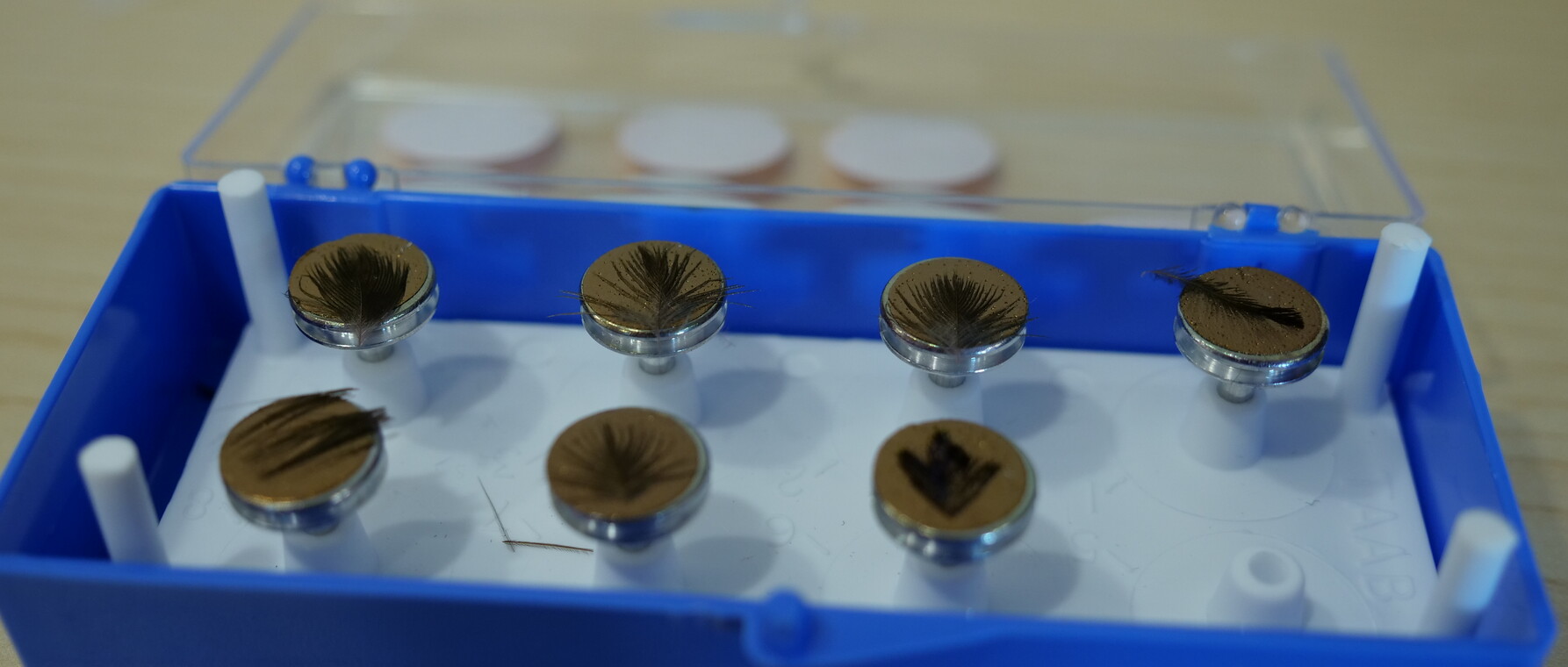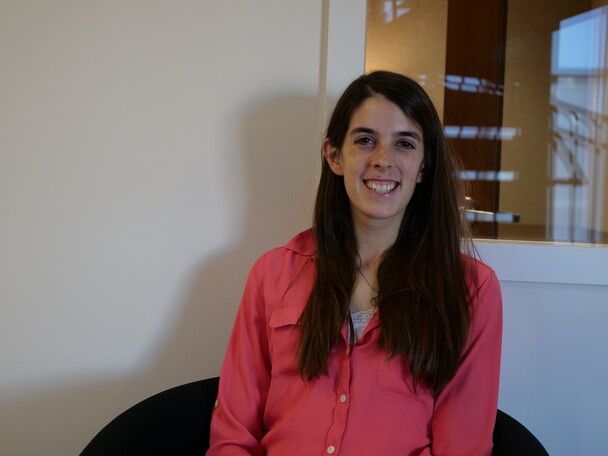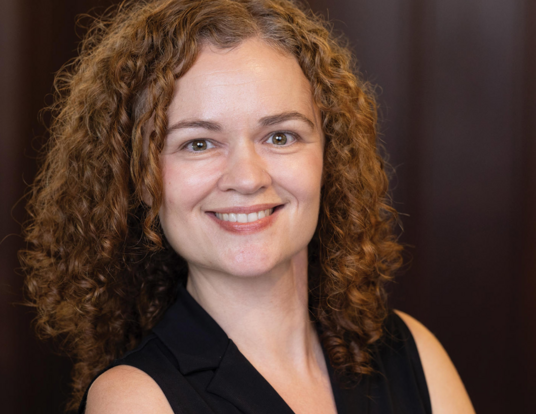Veritalk: Love is a Battlefield
The first episode in our miniseries about Plumage.

Veritalk is a podcast produced at Harvard’s Graduate School of Arts and Sciences. In each three-episode miniseries of Veritalk, you’ll hear how PhD students from different fields are trying to answer really big questions about the world.
Subscribe on Apple Podcasts or Stitcher.
In this episode, PhD student Dakota McCoy, who studies Organismic and Evolutionary Biology, asks why birds of paradise evolved to have brightly colored feathers. Then she asks an even bigger question: Why did some of these brightly colored birds also develop super-black feathers?

Full Transcript
I mean, why?
ANNA FISHER-PINKERT: From the Harvard Graduate School of Arts and Sciences, you’re listening to Veritalk. Your window into the minds of PhDs at Harvard University.
I was curious. . . I’ve always wondered. . . why?
For the next few episodes, we’re talking about Plumage: From birds to bling – the very deep reasons behind the most superficial things on earth.
Episode 1: LOVE IS A BATTLEFIELD
Think about a moment in your life when you really felt like you looked amazing. Maybe it’s a first date, or your high school prom, or a black-tie wedding. Maybe it’s a day where you wore pop of red lipstick, or a bow tie, or a new pair of shoes. And looking good put a little spring in your step, made you strut a little bit. And you got to kind of. . . peacock.
And there’s a reason we use that word, “peacock” – because when we adorn ourselves with frivolous decoration, we’re mimicking something that happens in nature all the time.
To better understand plumage in nature, I decided to ask a PhD student to come into the studio and talk about her research.
DAKOTA MCCOY: I'm Dakota McCoy. I study evolutionary biology at Harvard.
AFP: Dakota is a PhD student in organismic and evolutionary biology. She’s an ornithologist who studies these tiny birds that could out-peacock the peacock.
DM: Birds of paradise live in Papua New Guinea . . . all over in forests and on mountains. Most of them are fruit eaters and they're relatively isolated from predators as well where they live. So, in birds of paradise, the males are the ones that are very beautiful and elaborate, and they have incredibly elaborate traits. They have really vivid color ranging from shiny blue to bright red. They have crazy feather ornaments like ribbon like tails and little flag like feathers.
AFP: If you haven’t seen a bird of paradise before, these are intense birds. And there are a lot of different kinds. Some have bright turquoise heads, tail feathers twice the length of their bodies, or decorative feathers sticking straight up from their heads. And if that wasn’t enough, they also dance.
DM: Males do really elaborate displays for the females. You should check it out on YouTube. Not every male gets to mate with females. That's why it's there's so much intense pressure for the male to be the very best males that females choose him because females get to choose in these species.
AFP: Birds of paradise have prioritized looking cool for potential mates over hiding out from predators. Who among us hasn’t worn something really impractical to impress a date? But this sex selection problem brings up an important question:
DM: Why do birds have such elaborate beautiful colors.
AFP: After all, having fancy, colorful feathers doesn’t help birds of paradise fly better or hide from predators. There has to be a reason that this species has evolved to have such elaborate decorative feathers. Dakota thinks about this evolution as an arms race – in which each generation of birds adds to the species’ arsenal of wild and crazy visual displays.

DM: Okay, so, I got interested in arms races when I met David Haig, who’s my current supervisor at Harvard. He’s a professor that studies conflict in evolution generally. And so I thought that in birds you could sort of model this elaborate plumage evolution as an arms race in two ways. One is an arms race between males to try to look better and better. And the second type of arms race it could be between female visual ability and male appearance.
AFP: Remember that the birds of paradise are fruit-eaters. It's important to have terrific color vision if you want to find red berries in the middle of a green forest.
DM: So, human eyes are somewhat similar to bird eyes in that we both see color. We have three types of cones, and birds have at least four where they can also see ultraviolet light. But birds not only have an extra cone type, they also have double cones, which are another type of eye cell, and sort of little oil droplets that filter out certain wavelengths of light. So bird eyes are incredibly well evolved to see color.
AFP: These two systems evolved together: Female birds develop really good color vision, and male birds develop colorful displays to take advantage of that vision, the females develop even color vision, the males develop more outlandish displays and so on and so on for generations of tiny little birds caught in an evolutionary arms race. I mean, who started this war?
DM: The money question, which you've brought up, is how exactly does this start. And that brings us back to why do birds look colorful at all. And that brings us back to the beginning of the arms race. And one way it could begin is this idea of honest signaling. So it could begin because males who look red are also healthier and if females happen to like red they and those healthy males have really healthy fit offspring and they sweep through the population doing very well. So maybe it starts as an honest signal.
AFP: Another idea in evolutionary biology is that the females’ preferences might be entirely arbitrary.
DM: Why do we like looking at bright colors? Why do we think rainbows are beautiful? It's not so easy to say why, but it's clear that we have that preference. That alone is enough to start the arms race.
AFP: There’s also a third theory, a newer theory in evolutionary biology called “sensory bias.”
DM: If you are a bird that has evolved to eat orange fruit you're going to probably evolve to like how orange fruit look and be attracted to orange fruits. So you'll fly over and eat the tasty orange fruit. So if a male develops a beautiful orange patch on his wing, it might kind of. . . you might kind of kind of spill over your preference for the fruit spills over and you start to prefer that male. This is an idea called sensory bias and that's what I think. I think that's a very sort of solid idea for how the arms race might get started.
AFP: OK. But that said I probably shouldn't dress like a hamburger to attract a mate.
DM: I'd like I'd like you to and then let me know how it goes.
AFP: So a bird without the flashiest colors and swoopiest tail feathers is basically wearing the bird equivalent of last season’s fashions. But what’s interesting about birds of paradise is that they don’t just have flashy, colorful feathers.
DM: They also have a mysterious really dark black velvety plumage, and that plumage is always found right next to some of their really bright colors. So that was very mysterious. And with my collaborators, so Rick Prum is a professor at Yale studying the evolution of beauty, and then two other people, Teresa Feo and Todd Harvey . . . We started trying to understand first how is it making such an incredibly dark black -- such an absorbent surface. And then also why -- you know, usually in this kind of evolution you see beautiful colors, you don't really see black, you know? Where there's no color at all. So those are the questions we decided to investigate.
AFP: Dakota brought me some feathers that have this “super black” color.
DM: It’s a tiny feather, but feel free to hold it. Feathers are very tough so we don't have to worry too much about damaging them there.
AFP: Are they really? I did not know they were really tough.
DM: Yeah they're made out of keratin most of the wood is the same thing like our fingernails are made out of. So here's a cool one this is a bird of paradise where within a single feather you see both incredibly black and really, really bright structural color like coppery red.
AFP: Oh my god!
AFP: The feather that Dakota handed me is smaller than my fingernail, and when you hold it up to the light, it looks like there’s a shiny red-gold band, almost like a piece of jewelry, sitting on top of a black velvet background.
DM: Here’s one with really, really dark black and then a really bright blue tip. You have to kind of angle it to get to see the blue.
AFP: Wow.
AFP: And this one. . . it kind of looks like one of the photos from the Hubble telescope, where you can see the blue of a nebula is set against a black void.
DM: Birds like crows and chickadees don’t have, necessarily, this kind of super velvety black. If you look at a bird and it looks kind of shiny, that’s a different kind of thing, and that’s not the kind of thing I’m talking about. This is relatively rare, though with Rick Prum we’re looking at it in many species that have these kinds of sexually-selected arms races. What it really looks like is sort of a black hole looks fuzzy your eyes can't quite even focus directly on it because there's no little white shiny bits. . .you know, balloons have white shiny highlights, essentially. These feathers do such a great job of absorbing light that there are no shiny highlights.
AFP: In the plumage arms race, the male bird of paradise has come up with an entirely different type of weapon: An optical illusion.
DM: Why would a bird want to have really dark black when we know that birds prefer beautiful, bright colors? So, what we decided is that all animals have structures in their brain and structures in their eyes that help them see color accurately, whether it's night or day, whether something is in the shadow or in the bright sun. So that's why if you're looking at an apple, say, it looks red whether you're holding it in the shade or holding it under a bright light. That's because our eyes and brains correct for ambient light. And so this “super black” tricks an observer, tricks the females that the males are displaying to, into seeing that the color next to the super black -- it looks like it's in shadow. And so if it's looking that bright in shadow, it must be a really, really bright color, indeed.
AFP: In the same way that a jeweler might sell you a gold watch by placing it on top of velvety black fabric, the male bird of paradise is selling his colorful feathers by setting them against a blacker-than-black background.
DM: This whole question of why the feathers are so black, and the hypothesis that it's a way to exaggerate how beautiful the color is next to it -- It certainly works on human eyes if you look at a video of these birds or if you look at a bright you know a bright dot moving across a black background and onto a white background it does look way better on the black background. And the question is does this kind of beautiful effect -- it almost looks like it's glowing, like it's self-luminous – would this work on bird eyes? A few people have studied this in humans and in goldfish. It’s great news for us that they studied it in goldfish, because they also have four types of cones, just like birds. So all evidence points to the idea that almost certainly birds see the same optical illusion that we do, even though their eyes are much better adapted to see color, because the super black plumage takes advantage of such a basic feature of animal eyes.
AFP: So that’s why you’d want to produce super-black feathers, but what about how? How do you make a feather that is blacker than black?
DM: The way that feathers make color, there's traditionally two mechanisms. One is pigments. And these are molecules that selectively absorbs certain colors of light certain wavelengths of light. A red pigment would absorb everything except for red, and reflects red. Our eyes see, you know, the reflected light not the absorbed light.
AFP: These pigments usually come from something the bird eats. So, a bird might eat a particular kind of red berry, and then store that red pigment in its feathers. No berries? No pigment. But there’s another way to make color in nature.
DM: And the second mechanism is structural color. This is what you see on shiny peacock tails or on oil slicks. You know it changes depending on the way you look at them. These make that color through tiny structures at the scale of the wavelength of light. So some around like 300 to 700 nanometers it could be little rows of granules it could be matrices with air interspersed with the type of protein called keratin and that's how birds create colors like shiny hummingbirds or blue is also a structural color.
AFP: If you cut a green hummingbird feather in half and look at it under a very powerful microscope, you wouldn’t really see the color green any more. You’d see a particular structure that reflects light in a unique pattern. Zoom back out, and you see the feather as green because that nanostructure reflects back green light to your eye.
DM: But what we discovered is that the black is not just a pigmentary color, and not just a traditional structural color. It’s a new kind of structural color where it has tiny little microstructures, basically little vertical arrays that repeatedly scatter light and create this incredibly absorbent light trap, basically. So that's how they're making the incredibly absorbent velvety black plumage. So instead of just having a fractal-like feather sitting in one plane, little pieces of the feather curve upwards and basically create these little light traps. So that's why it's different than the sort of nano-structural cross-section-y structural color that people have looked at in the past.
AFP: If you’ve heard of “vantablack” - the blacker-than-black substance that was made in a lab in the UK, it’s based on the same idea. Vantablack is made of lab-grown nano “tubes” that are all vertically aligned. Zoom in on super-black feathers, and you see a really similar structure at the micro-scale. This structure is incredibly good at absorbing light. Though, Dakota points out that the feathers are a little more irregular. The super black feathers look like pine needles, or like coral reefs, whereas the lab-made vantablack is made up of evenly spaced cones and pits. It turns out that there is a whole world of plumage-inspired, lab-made color, and that's what we're going to explore next time on Veritalk.
Annie Stephenson: When the particles are very highly charged, they all want to get far away from each other as possible. And it creates this crystal structure, this highly ordered structure, which is exactly the structure that we talk about is required to make an iridescent structural color.
AFP: It really looks like some sort of unicorn in a bottle.
Victoria Hwang: Unicorn blood.
Laughter
AFP: Right!
AFP: Next week, Plumage Chapter 2: The Wild Blue Yonder
AFP: Thank you for listening. Veritalk is produced by me, Anna Fisher-Pinkert at the Harvard Graduate School of Arts and Sciences. Our executive producer is Ann Hall. Our sound designer is Ian Coss. Stay tuned for more Veritalk, and subscribe to Veritalk on Apple Podcasts, Stitcher, or Soundcloud.
Get the Latest Updates
Join Our Newsletter
Subscribe to Colloquy Podcast
Simplecast




